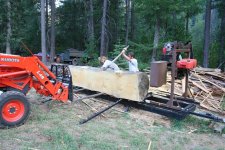Well ... just down the road from where I live, we had a pretty big tree that was destroyed by a thunderstorm in 2002. This particular tree had some history:
Maryland's State Symbol Falls in June 6, 2002 Storm
The Wye Oak, Maryland's State Tree and the largest White Oak in the United States, toppled June 6, 2002 during a thunderstorm in the village of Wye in Talbot County on Maryland's Eastern Shore. Believed to be more than 460 years old, the beloved tree was purchased by the State Maryland in 1939, and was declared Maryland's State Tree in 1941. The purchase marked the first time in American History that a government agency purchased a single tree for preservation. The Wye Oak was one of Maryland's greatest living symbols and was older than the State itself.
Maryland's first State Forester, Fred W. Besley, made the first official measurement of the Wye Oak in 1909. Besley was amazed at the size and breadth of the tree, and it quickly gained notoriety as the "largest and finest specimen of white oak in the country." The tree soon received national recognition in a November 1919 issue of American Forests magazine that created a national Hall of Fame for trees, and include the "Wye Mills Oak" as its first nominee. In 1940, the American Forestry Association held a nationwide contest to locate "the largest living specimens of American trees..." Again, the Wye Oak was the first tree nominated, and held its title until the recent storm, and one of only two trees to have survived since the contest began.
Notable Wye Oak facts:
The tree measured 31 feet 8 inches in circumference, 96 feet tall, crown spread of 119 feet - covering nearly one-third acre.
Lightning rods were installed on the tree in the 1940's, and its crown was stablized by more than a hundred yards of steel cable.
At one time a chicken yard occupied the base of the tree. A large depression in the tree's base remained perpetually filled with water, from which the chickens drank and bathed. It was thought that a mysterious underground spring supplied the pool, but was actually rainwater collected from the tree's branches and trunk.
1937 Photograph:







